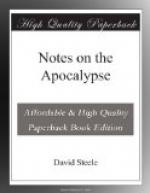No character in history at the time referred to, so well agrees to the symbol of a fallen star as the monk Sergius, who is known to have been the coadjutor of Mahomet. He had been a monk of the Christian sect called Nestorians from Nestorius their leader. This monk Sergius had been excommunicated for heresy and immorality. He was glad to serve the devil as dictator to Mahomet in composing the Koran, which bears internal evidence of having been written by one who was acquainted with the Sacred Scriptures. When this degraded man had finished his task, he was put to death by his master, lest he should betray the imposture.
He opened the bottomless pit, from which issued a smoke darkening the whole face of the heavens. The pit is hell, whence came the smoke,—the diabolical system of delusion. From the same place comes the character afterwards to appear under the aspect of a beast, (ch. xi. 7.) Locusts constituted one of the plagues of Egypt, and they are the emblem of a destroying army. (Exod. x. 14-19; Joel i. 4-6.) And this is their import here. They represent the deluded and destructive followers of Mahomet, who in vast multitudes laid waste the nations of western Asia, southern Europe, and northern Africa. The Saracens, originating in Arabia, the national locality of the literal locusts, in great multitudes like clouds, laid waste the fairest and most populous portions of the earth for a succession of ages.
These symbolic locusts have also the property of scorpions, a poisonous reptile, resembling in some degree a lizard combined with a lobster, armed with a sting in the end of its tail. Wicked and impenitent men are compared to scorpions. (Ezek. ii. 6.) But these locusts are under restraint. They are permitted to hurt only “those men which have not the seal of God in their foreheads.” The time of their continuance is “five months,” of thirty days each, making 150 years,—“a day for a year.” (Ezek. iv. 6.) In the year 606, Mahomet began his imposture by retiring to the cave of Hera. In 612 he appeared publicly as the apostle of his new religion at the head of his deluded followers. Between 612 and 762, he and the warlike chiefs who succeeded him, overran with terrible destruction, Syria, Persia, India, Egypt and Spain. Although the Saracenic empire continued for a longer time, yet from this time it lost the disorderly Locust character and because a more settled commonwealth. In the year 762, the city of Bagdad was built by one of the caliphs, who called it “the city of peace.” This put a stop to the devastations of the locusts, when the empire began to decline. It was foretold, however, that during the time of successful war by these cruel invaders, they would inflict such miseries upon their wretched victims, that they would earnestly but vainly desire death to put an end to their exquisite torments. It is farther said that these locusts resembled horses, as indeed they do, especially in their heads. The Arabians excelled in horsemanship,




